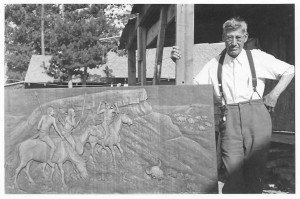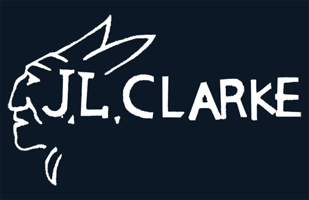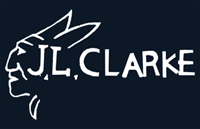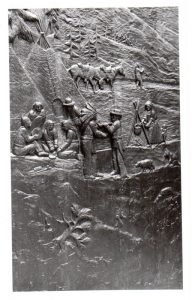Blackfeet Hospital
By Joyce Clarke Turvey
February 27, 1986
The new $9.2 million Blackfeet Community Hospital opened its doors on February 3, 1986, which was the result of an 18 year effort to improve medical facilities on the Blackfeet Indian Reservation. With dedication ceremonies slated for February 28th, there was an open house at the facility, as well as speeches by Congressman Pat Williams, Senator John Melcher, Deputy Director Office of Tribal Activities, James Smith and Tribal Council Chairman, Chief Earl Old Person. Speeches began at 1 PM followed by a buffalo feed sponsored by the tribe at 3:00pm.
Inside the hospital, Native American art work is represented by many local artists depicting the culture on the Blackfeet Reservation, including three panels and an Indian head bronze plaque by late Blackfeet artist, John L. Clarke. It is with love, pride and personal interest that I write about my father.
 Two of these large-scale 4x 9 foot carved panels are glass-enclosed and displayed inside the new hospital, with a smaller wood relief over the receptionist desk in the administration office. Depicting Indian life, the carving on the left is of an Indian encampment, and the frieze on the right is of buffalo being slaughtered at the jump.
Two of these large-scale 4x 9 foot carved panels are glass-enclosed and displayed inside the new hospital, with a smaller wood relief over the receptionist desk in the administration office. Depicting Indian life, the carving on the left is of an Indian encampment, and the frieze on the right is of buffalo being slaughtered at the jump.
Originally commissioned by the government for the first Blackfeet Hospital (started in 1935 and completed in 1936), Clarke carved the panel of the Indian encampment in 1923 and the other two later. These were placed on either side of the door of the entrance in the original hospital, with the smaller one above the door, where they remained until they were seriously mutilated by vandalism in later years.
Due to the dedication and efforts of Hospital Maintenance Foreman, Charley Thomas, the grandson of Wades-in-the-Water, these bas-relief works of art would have been vandalized further had they not been removed from the hospital in about 1965 and stored at the Museum of the Plains Indian for several years. In 1978, they were moved to the Boarding School where they were restored expertly by Blackfeet artist, Albert Racine (1907-1983), who was well known as a wood carver and for his famous “Napi” character. The tribe paid Racine $3,500 to do the restoration and the panels were kept at the old hospital until the new one was completed.
The panels, sculpted of Philippine mahogany, measure 8 inches deep and the two large ones weigh about 800 pounds each. It was a tremendous undertaking by the artist to laminate the wood pieces to create the panels and carve into the hard wood, which he did with special wood-carving tools, many of which he fashioned and made himself.
John Louis Clarke was born in Highwood, Montana on May 10, 1881 of a Blackfeet mother, Margaret, whose Indian name was First Kill, and father, Horace J. Clarke, who was half Blackfeet and half Scottish. The Clarke family was the first to settle in Midvale in 1888, which is now East Glacier Park. At the age of about two and a half years, John was stricken with scarlet fever, which left him permanently deaf.
Although handicapped and self-taught, he was a tremendously prolific artist and issued a prodigious number of carvings, sculptures and paintings during his lifetime. He often signed his woodcarvings with his Blackfeet Indian name of Cutapuis, which means “The Man Who Talks Not.” Still carving until his death on November 20, 1970, at age 89, Clarke could look back at honors and exhibiting his sculptures and carvings in many galleries including London, Paris, New York, Boston and Chicago. In 1918, he was awarded a gold medal by the American Art Galleries of Philadelphia and a silver medal from the Spokane Art Association in 1928, as well as being listed in the 1940 edition of Who’s Who, American Art Annual.
His wood carvings of bear, mountain goat and other wildlife drew attention and recognition and were acquired by many collectors and notables such as the late President Warren G. Harding, John D. Rockefeller, Jr., Johns-Manville, Louis Hill, Sr., and famed cowboy artist, Charles M. Russell.During the 1930s and 40s, Clarke received several important commissions to execute large-scale carved panels to embellish public buildings. Besides the Browning Hospital, they were for the University of Montana, Missoula and the Museum of the Plains Indian, where they are still above the entrance doors. In May 1985, the 1800-pound wood relief of the Plains Indians was moved from the Harry Adams Field House at the University of Montana to be on loan at the Montana School for the Deaf and Blind and was displayed in the school’s library.
Probably his most ambitious undertaking was for the Pioneers Memorial building in Helena, where Clarke carved a 4×13 foot panel in 1956, which involved a ton of woodcarving.
His prominence as an artist is listed in such books as Bronzes of the American West by Patricia Janis Broder, Artists of the American West and New Interpretations by Montana author, Dale Burke, as well as numerous magazine articles. In his lifetime, Clarke was generally considered the best portrayer of western wildlife in the world. In 1977, I established the John L. Clarke Western Art Gallery & Memorial Museum in his honor at the site of his home and studio in East Glacier Park.
Thus after more than twenty years of being in storage, the magnificent bas-relief works of art by John Louis Clarke have been returned to where they belong at the Blackfeet Community Hospital to be seen and admired for generations to come – a fitting tribute of recognition of his artistry.



